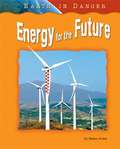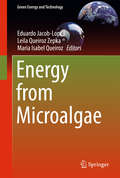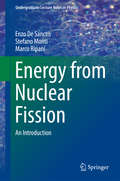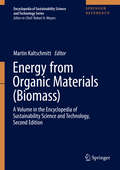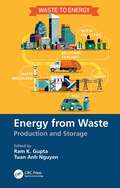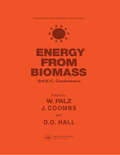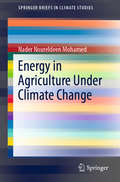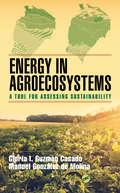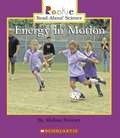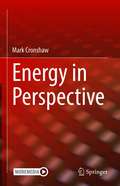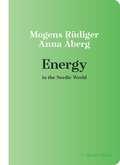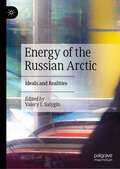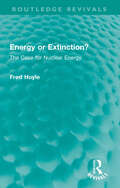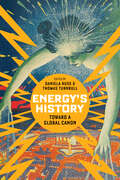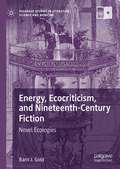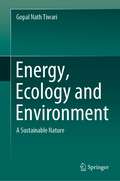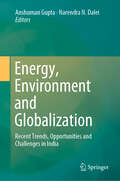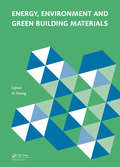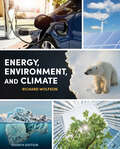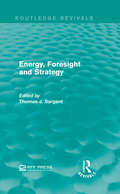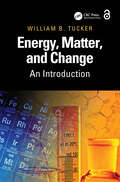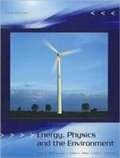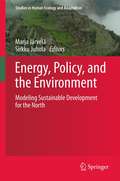- Table View
- List View
Energy for the Future (Earth in Danger)
by Helen OrmeBurning fossil fuels, such as oil and coal, may be accelerating Earth's climate change. How can we develop clean, renewable sources of energy and reduce our dependence on fossil fuels? Energy for the Future clearly presents the pros and cons of alternative energy sources-- from wind, water, and solar power to bio-fuels, hydrogen fuel cells, and nuclear power. A section in the back of the book will inspire young environmentalists by suggesting ways they can help protect their planet.
Energy from Microalgae (Green Energy And Technology)
by Eduardo Jacob-Lopes Leila Queiroz Zepka Maria Isabel QueirozThis book presents an authoritative and comprehensive overview of the production and use of microalgal biomass and bioproducts for energy generation. It also offers extensive information on engineering approaches to energy production, such as process integration and process intensification in harnessing energy from microalgae. Issues related to the environment, food, chemicals and energy supply pose serious threats to nations’ success and stability. The challenge to provide for a rapidly growing global population has made it imperative to find new technological routes to increase the production of consumables while also bearing in mind the biosphere’s ability to regenerate resources. Microbial biomass is a bioresource that provides effective solutions to these challenges.Divided into eight parts, the book explores microalgal production systems, life cycle assessment and the bio-economy of biofuels from microalgae, process integration and process intensification applied to microalgal biofuels production. In addition, it discusses the main fuel products obtained from microalgae, summarizing a range of useful energy products derived from algae-based systems, and outlines future developments. Given the book’s breadth of coverage and extensive bibliography, it offers an essential resource for researchers and industry professionals working in renewable energy.
Energy from Nuclear Fission
by Enzo Sanctis Stefano Monti Marco RipaniThis book provides an overview on nuclear physics and energy production from nuclear fission. It serves as a readable and reliable source of information for anyone who wants to have a well-balanced opinion about exploitation of nuclear fission in power plants. The text is divided into two parts; the first covers the basics of nuclear forces and properties of nuclei, nuclear collisions, nuclear stability, radioactivity, and provides a detailed discussion of nuclear fission and relevant topics in its application to energy production. The second part covers the basic technical aspects of nuclear fission reactors, nuclear fuel cycle and resources, safety, safeguards, and radioactive waste management. The book also contains a discussion of the biological effects of nuclear radiation and of radiation protection, and a summary of the ten most relevant nuclear accidents. The book is suitable for undergraduates in physics, nuclear engineering and other science subjects. However, the mathematics is kept at a level that can be easily followed by wider circles of readers. The addition of solved problems, strategically placed throughout the text, and the collections of problems at the end of the chapters allow readers to appreciate the quantitative aspects of various phenomena and processes. Many illustrations and graphs effectively supplement the text and help visualising specific points.
Energy from Organic Materials (Encyclopedia Of Sustainability Science And Technology Ser.)
by Martin KaltschmittThis comprehensive reference is a state-of-the-art survey of biomass as an energy carrier for the provision of heat, electricity, and transportation fuel, considering technical, economic, environmental, and social aspects. On a global scale, biomass contributes roughly 12 to 16 % of the energy needed to cover the overall primary energy consumption. Thus far, it is humanity’s most important source of renewable energy, used on practically all continents and growing in importance even in industrialized nations. With detailed coverage of the production of solid, gaseous and liquid fuels, as well as a final energy provision, this volume serves as an introduction for readers just entering the field, but also offers new insights, up-to-date information, as well as latest findings for advanced researchers, industry experts, and decision makers.
Energy from Waste: Production and Storage
by Ram K. GuptaConversion of waste into value-added products such as energy transforms a potential environmental problem into a sustainable solution. Energy from Waste: Production and Storage focuses on the conversion of waste from various sources for use in energy production and storage applications. It provides the state-of-the-art in developing advanced materials and chemicals for energy applications using wastes and discusses the various treatment processes and technologies. Covers synthesis of usable materials from various types of waste and their application in energy production and storage Presents an overview and applications of wastes for green energy production and storage Provides fundamentals of electrochemical behavior and understanding of energy devices such as fuel cells, batteries, supercapacitors, and solar cells Elaborates on advanced technologies used to convert waste into green biochemical energy This work provides new direction to scientists, researchers, and students in materials and chemical engineering and related subjects seeking to sustainable solutions to energy production and waste management.
Energy from the Biomass: Third EC conference
by W. Palz J. Coombs D. O. HallThis book is based on third European Conference on Energy from Biomass held in Venice. It covers energy security, environmental aspects, relieving the overproduction in some agricultural sectors and creation of jobs in rural areas.
Energy in Agriculture Under Climate Change (SpringerBriefs in Climate Studies)
by Nader Noureldeen MohamedThis book discusses the role of energy in agriculture which reaches 30%, and the role of agriculture in energy where the water shred by 17% in total electricity generation in addition to the role of bioenergy as a source of liquid energy. Climate change and global heating will increase the temperature and that will affect plant growth, water availability and the share of electricity in agriculture and other energy phases in agriculture. Global heating means more water pumping, more uses of fertilizers and pesticides in which intensive power consumption in addition to need of more electricity for air-condition inside the greenhouses, the manufacturing of hormone and plant growth organizers will also consume more energy. Finally, the book explains why the water, energy and food become one nexus and the interaction and interference between them.This book will have valuable information for both students and faculties of engineering and agriculture in addition to research centers, water institutions and climate change specialists.
Energy in Agroecosystems: A Tool for Assessing Sustainability (Advances in Agroecology)
by Gloria I. Casado Manuel Gonzalez de MolinaEnergy in Agroecosystems: A Tool for Assessing Sustainability is the first book on energy analysis that is up-to-date and specifically dedicated to agriculture. It is written from an agroecological perspective and goes beyond the conventional analysis of the efficient use of energy. The book provide a methodological guide to assess energy efficiency and sustainability from an eco-energetic point of view. <P><P> Case studies from both Europe and America, which are representative of today’s most used scales of analysis (crop, farm, local or national) and the different farm management practices (traditional, industrialized, and contemporary organic), apply this methodology This book will be of primary interest to researchers, practitioners, and students working in the areas of agroecology, sustainable agriculture, environmental science, energy analysis, natural resources management, rural development and international development.
Energy in Motion
by Melissa StewartThis is a science book meant for children and introduces energy through motion using common objects around us.
Energy in Perspective
by Mark CronshawThis textbook provides broad coverage of energy supply and use. It discusses how energy is produced, transformed, delivered to end users, and consumed. The author discusses all of this at an undergraduate level, accessible to students of varying backgrounds. High-level and human-scale perspectives are included. As a high-level example, the book discusses the shares of global primary energy that are provided by oil, gas, coal, hydroelectricity, and renewables, as well as trends in energy consumption and supply over time. Human-scale examples will resonate with readers’ every day experiences. The link between economic development and energy consumption is presented, which facilitates understanding of how global energy consumption growth is inevitable as economic development occurs. Coverage includes separate chapters on the oil, natural gas, coal, and electricity sectors. Each of these provides high-level descriptions of the technology involved in the production of that type of energy as well as the processing and transportation that occurs to bring the energy to end users. The book discusses the technological implications of energy transitions such as increased use of renewables or changes in the use of nuclear energy using Germany and Japan as examples. It closes with a discussion of future energy use.
Energy in the Nordic World (Nordic World)
by Mogens Rüdiger Anna ÅbergNorway and Sweden are among the biggest consumers of energy per capita, yet the Nordic nations also lead the world in clean power production and have ambitious goals of decarbonizing their energy systems by 2050. Denmark, Norway, Sweden, Finland, and Iceland vary drastically in geography and the availability of natural resources, but each consistently generates electricity from renewable sources at multiple times the average rate of other high-income countries. Mogens Rüdiger and Anna Åberg present a concise and timely history of energy production, trade, and consumption in Norden, starting with a review of the regional energy mix—from wind, solar, tide and wave, geothermal, biomass, nuclear, coal, and gas sources. Brief chapters describe the diversity of Nordic energy markets, assess how far the green transition has come, and explore what comes next as global crises, domestic politics, and technological developments present novel challenges and opportunities. Energy infrastructures and economic activities, Rüdiger and Åberg argue, serve as unique cultural focal points in the region. The coauthors summarize the national policy frameworks for the sector as well as the key energy and economic indicators used in infrastructure planning, regulation, and the opening of the electricity and gas markets to free competition. Energy in the Nordic World is the essential primer to the power markets at the heart of Europe’s energy transition.
Energy of the Russian Arctic: Ideals and Realities
by Valery I. SalyginThis volume is an energy-tailored sequel to the research on the Arctic carried out at MGIMO University. Specifically, the proposed book is grounded in the profound academic and practical expertise of the specialized body of MGIMO University – International Institute of Energy Policy and Diplomacy chaired by Prof. Valery Salygin. Thus, the research exclusively focuses on energy-related aspects of exploration of the Arctic Zone of the Russian Federation (AZRF). This particular region with its ample oil and gas resources has been comparatively and critically studied by a team of authors representing Russia, USA, France, Switzerland, Slovakia, and Lithuania from legislative, political, economic, technical, transport, environmental, sustainability, and security perspectives.
Energy or Extinction?: The Case for Nuclear Energy (Routledge Revivals)
by Fred HoyleOriginally published in 1977 and as second edition in 1979, this book argues that without energy sources on a vast scale our present society cannot survive. According to the author, Fred Hoyle, the technology to tap solar, wind or wave power on a large enough scale just does not exist. He considers nuclear fission to be the only source currently capable of supplying our needs. The author fills in the scientific background necessary to appreciate his arguments in his lucid, direct style, so that the book can act as an ideal introduction for those unfamiliar with the energy debate. This short book is unashamedly provocative and many of the central tenets of it remain as relevant today as when it was first published.
Energy's History: Toward a Global Canon
by Daniela Russ and Thomas TurnbullEnergy history is an approach to understanding the past that takes changes in the human exploitation of Earth's energies as its object of inquiry. This interdisciplinary field documents and analyzes how humans have thought about, harnessed, stored, and exploited stocks and flows of energy. In recent decades, in response to evidence of the effect of fossil fuel use in our climatic system and coinciding with an energy turn across the humanities, a new urgency and purpose has been ascribed to such work. Energy's History challenges abstract and universalizing conceptions of energy's history-making capacities. Each of the twelve essays in this collection presents, analyzes, and contextualizes a primary source. The contributors focus on ideas, events, and statements that recorded and critiqued the distinct historical paths of energy, thereby broadening the scope of where and what constitutes energy history. As energy's world-making has enmeshed ever more of the planet into a dangerous compact with fossil fuels, energy histories must be revised within this new energy-historical reality. This volume both presents persuasive visions of energy-driven development beyond the Western capitalist model and provides an expansive and critical account of the ways in which energy histories have shaped the past and impact the present.
Energy, Ecocriticism, and Nineteenth-Century Fiction: Novel Ecologies (Palgrave Studies in Literature, Science and Medicine)
by Barri J. GoldEnergy, Ecocriticism, and Nineteenth-Century Fiction: Novel Ecologies draws on energy concepts to revisit some of our favorite books—Mansfield Park, Jane Eyre, Great Expectations, and The War of the Worlds—and the ways these shape our sense of ourselves as ecological beings. Barri J. Gold regards the laws of thermodynamics not solely as a set of physical principles, but also as a cultural and conceptual form that we can use to reimagine our historically vexed relationship to the natural world. Beginning with an examination of the parallel inceptions of energy and ecology in the mid-nineteenth century, this book considers the question of how we may better read and interpret our world, developing a recipe for experimental reading and insisting upon the importance of literary studies in a world driving to ecological catastrophe.
Energy, Ecology and Environment: A Sustainable Nature
by Gopal Nath TiwariThis book covers topics related to climate change, weather, greenhouse effect, solar energy, various cycles including carbon, hydraulic, sulphur, renewable energy conservation, ecology and sustainable environment. The contents of the book include pedagogical elements, such as exercises, tables and figures at appropriate places in each chapter, including problems and objective questions at end of each chapter, to aid in learning. Further, the unit conversion from FPS system to SI unit of each parameter, namely length, energy, power, velocity and pressure force, etc, and some standard constants used in examples are also provided in the book. The book also includes discussion about renewable energy sources, namely solar energy, wind energy, biomass energy and geothermal energy, etc, their availability and eco-friendly nature. This book can be a useful reference for those in academia and industry.
Energy, Environment and Globalization: Recent Trends, Opportunities and Challenges in India
by Anshuman Gupta Narendra N. DaleiThis book analyzes contemporary issues relating to energy, environment, and globalization in the Indian context. As a signatory to the Paris climate accord, India has reiterated its commitment to taking strong and positive steps toward climate change mitigation. However, as one of the fastest growing economies in the world, it is battling the effects of a steep rise in fossil fuel usage and pollution. Further, increasing globalization is leading to greater economic activity and production, resulting in additional energy use, which has a negative effect on the environment. The book argues that globalization need not have only a negative environmental impact; it can also have positive impact through the importation of environmentally sound technologies and implementing global compliance standards. The book is divided into three sections: The energy section discusses issues relating to the status of Indian natural gas market and the need for developing an efficient gas market in India; the economics and politics of sustainable energy in India; the challenges of thermal power and significance of clean thermal power generation in India; environmental and policy issues concerning energy use in urban India; the importance of energy use in developing Human Development Index (HDI); and issues relating to renewable energy in India. The environment section then examines topics such as the impact of global warming on local weather by examining the frequency of extreme weather events such as drought and floods, and their impact on farming activities in the Indian state of Odisha; the importance of according the economic value to environmentally significant things like national park , mangroves, etc. for sustainable development; the role of environmental accounting for ecological sustainability and ecotourism; and environmental concerns increasingly gaining traction among the corporate sector for their long-run benefits . Lastly, the third section addresses issues relating to the challenges and opportunities of globalization, such as the interface between globalization and environment; managing India’s business interest in proposing new Bilateral Investment Treaty (BIT); the challenges being faced by Indian exports and their revival; and making Indian SMEs competitive. As such, it is an invaluable resource for policymakers, researchers, practitioners and students in the field of energy, environment and trade economics.
Energy, Environment and Green Building Materials: Proceedings of the 2014 International Conference on Energy, Environment and Green Building Materials (EEGBM 2014), November 28-30, 2014, Guilin, Guangxi, China
by Ai ShengThis proceedings volume contains selected papers presented at the 2014 International Conference on Energy, Environment and Green Building Materials, held in Guilin-Guangxi, China. Contributions cover the latest developments and advances in the field of Energy, Environment and Green Building Materials.
Energy, Environment and Sustainable Development
by Mohammad Aslam Uqaili Khanji HarijanNew information and strategies for managing the energy crisis from the perspective of growing economies are presented. Numerous case studies illustrate the particular challenges that developing countries, many of which are faced with insufficient resources, encounter. As a result, many unique strategies to the problems of energy management an conservation, environmental engineering, clean technologies, biological and chemical waste treatment and waste management have been developed.
Energy, Environment, and Climate (Fourth Edition)
by Richard WolfsonHelp students understand and prepare for a changing energy landscape. With major updates to its coverage of climate and sustainability—particularly as it relates to the latest IPCC reports, trends towards electrification in transportation, and energy policy—the new Fourth Edition of Energy, Environment, and Climate is the most modern, up-to-date text for your energy course.
Energy, Foresight and Strategy (Routledge Revivals)
by Thomas J. SargentThe essays in Energy, Foresight and Strategy apply rational expectation theory to various energy markets with the intention of discussing issues relevant to analysis and decision making in the whole of the energy field. Originally published in 1985, issues explored include oil exportation, energy prices and embargoes, both focussing on how past regulation has created issues in the market at the time of publication as well as creating models to ascertain the futures of various energy resources. This title will be of interest to students of Environmental Studies and Economics.
Energy, Machines, and Motion: Student Guide and Source Book
by National Science Resources CenterNIMAC-sourced textbook
Energy, Matter, and Change: An Introduction
by William B. TuckerThis textbook serves as an introduction to the field of chemistry, aimed at secondary school students, and it assumes no prior knowledge on the readers’ part. As an introductory text, the book emphasizes fundamental skills that are necessary for chemistry, and science generally. This includes an emphasis on good writing and a focus on problem solving, with problems incorporated throughout the text. To help prepare students to pursue chemistry further, all information presented is in accord with the International Union of Pure and Applied Chemistry’s style and technical guidelines and supported through citations to the primary literature.The Open Access version of this book, available at http://www.taylorfrancis.com, has been made available under a Creative Commons [Attribution-Non Commercial-No Derivatives (CC-BY-NC-ND)] 4.0 license.
Energy, Physics And The Environment
by J. L. Campbell E. L. McFarland J. L. HuntEnergy, Physics and the Environment provides a foundational quantitative account of energy and related environmental issues for university students in science who have a first-year preparation in Physics. The text discusses the numbers involved in the various dimensions of the overall energy issue in order to help the reader develop a quantitative grasp on them. This third edition book features an expanded section on uranium resources and the most updated data available. Energy, Physics and the Environment gives students the opportunity to study current energy supply concerns and the impact that energy supply shortage has on the environment.
Energy, Policy, and the Environment
by Sirkku Juhola Marja JärveläThis book sets the questions of energy and the environment in the North in the global context and further addresses historical developments, views on energy taxation and tariffs, and effects of EU energy policy. Climate change appears more frequently than ever on the top of global and national policy agendas. In the current situation traditional environmental concern and environmental policy may not suffice in the face of the global challenge as manifested by climate change and the depletion of fossil energy resources. But as new data comes to light, new energy policies and changes in economic structures are crucial for putting into action global climate policy. Crucial tasks in environmental policy are the sustainable utilisation of natural resources and the conservation of natural and human-made habitats. One of the areas of the world where this comes into play the most is in the Nordic countries. Northern societies are predominantly high tech, high consumption and high energy supply societies. And with the transition from older energy sources (wood for heating and stream water for power production) to newer ones (oil and nuclear energy) discussions on the environmental impact have led to public and corporate action. The Northern countries have been at the forefront in finding sustainable alternatives to solve conflicts arising from the rise in energy needs. However, these countries have taken different pathways with different policies in attempting to achieve this. As the needs and concerns from climate change arise, a Northern dimension, involving policies that contrast to European and global trends, emerges. Energy, Policy, and the Environment: Modeling Sustainable Development for the North explores that dimension.
